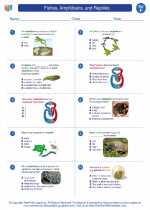Fishes, Amphibians, and Reptiles -> precipitation
Precipitation
Precipitation is a vital part of the earth's water cycle. It refers to any form of water, liquid or solid, that falls from the atmosphere and reaches the ground. This can include rain, snow, sleet, hail, and drizzle.
Types of Precipitation
- Rain: Rain is liquid water droplets that fall from the atmosphere when the temperature is above freezing.
- Snow: Snow forms when water vapor directly turns into ice crystals in the atmosphere and falls to the ground as snowflakes.
- Sleet: Sleet occurs when raindrops freeze into ice pellets before reaching the ground.
- Hail: Hail is formed when strong updrafts in thunderstorms carry raindrops upward into extremely cold areas of the atmosphere, where they freeze into ice pellets. These pellets can grow larger as they are carried up and down by the updrafts before finally falling to the ground.
- Drizzle: Drizzle consists of very small water droplets that are smaller than raindrops and are very close together.
Formation of Precipitation
Precipitation is formed through the process of condensation and coalescence. When water vapor in the atmosphere cools and condenses into liquid water droplets or ice crystals, they come together to form clouds. As these droplets or crystals grow larger and heavier, they eventually fall to the ground as precipitation.
Factors Affecting Precipitation
Several factors can influence the type and amount of precipitation that occurs in a particular area. These factors include:
- Temperature: The temperature determines whether precipitation falls as rain, snow, sleet, or hail.
- Humidity: The amount of moisture in the air affects the formation and intensity of precipitation.
- Wind: Wind patterns can impact the distribution of precipitation, causing areas of heavy or light rainfall.
- Topography: The shape of the land can influence precipitation patterns, with mountains causing orographic precipitation and rain shadows.
Importance of Precipitation
Precipitation is essential for sustaining life on Earth. It provides the necessary water for plants to grow, replenishes freshwater sources such as rivers and lakes, and maintains the balance of ecosystems. Additionally, precipitation plays a crucial role in regulating the earth's climate and weather patterns.
Study Guide
To understand precipitation better, here are some key points to focus on:
- Describe the different types of precipitation and the conditions under which they form.
- Explain the process of condensation and coalescence in the formation of precipitation.
- Discuss the factors that influence precipitation, including temperature, humidity, wind, and topography.
- Explore the importance of precipitation for the environment and human activities.
Understanding precipitation is crucial for comprehending the earth's water cycle and its impact on the environment. By mastering this topic, you will gain valuable insights into the dynamics of weather and climate patterns.
.◂Science Worksheets and Study Guides Sixth Grade. Fishes, Amphibians, and Reptiles

 Activity Lesson
Activity Lesson
 Worksheet/Answer key
Worksheet/Answer key
 Worksheet/Answer key
Worksheet/Answer key
 Worksheet/Answer key
Worksheet/Answer key
 Worksheet/Answer key
Worksheet/Answer key
 Vocabulary/Answer key
Vocabulary/Answer key
 Vocabulary/Answer key
Vocabulary/Answer key
 Vocabulary/Answer key
Vocabulary/Answer key
 Vocabulary/Answer key
Vocabulary/Answer key
 Vocabulary/Answer key
Vocabulary/Answer key
